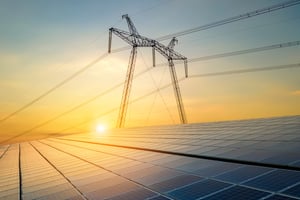Extreme cold weather can pose significant challenges to the electrical grid's reliability. As we've...
AI-Powered Grids: The Future of Efficient Renewable Energy
The shift towards renewable energy is crucial for sustainability but introduces complex challenges like grid congestion and intermittency. The traditional approach of expanding physical infrastructure may seem like the only solution, but it's both costly and time-consuming. Instead, a more strategic, efficient, and cost-effective approach lies in harnessing the power of Artificial Intelligence.
AI: A Game-Changer for Grid Management
From predictive analytics and grid optimization to energy storage efficiency and dynamic demand response management, AI is transforming how we manage and utilize energy resources for a more sustainable future:
- Predictive Analytics and Grid Optimization: AI's ability to analyze vast amounts of data and predict trends is invaluable for grid management. AI enables more efficient energy distribution by accurately forecasting energy demand and renewable energy output. This reduces the need for expensive infrastructure expansions, as the existing grid can be utilized more effectively.
- Enhancing Energy Storage Efficiency: AI can optimize energy storage systems' charging and discharging cycles, like batteries, ensuring they operate at peak efficiency. This means less energy is wasted, and the grid can rely more on stored renewable energy, reducing the dependency on traditional energy sources.
- Dynamic Demand Response Management: AI can manage and automate demand response programs, instantly adjusting energy supply in response to consumption patterns. This alleviates grid congestion and ensures a more balanced and efficient use of renewable energy sources.
- Intelligent Grid Maintenance and Fault Prediction: AI algorithms can predict and identify potential issues in the grid before they occur, leading to proactive maintenance. This reduces downtime and increases the grid's reliability, lessening the need for extensive physical infrastructure.
The Economic Argument: Cost-Effectiveness of AI over Infrastructure
Investing in AI is not only technologically savvy but also economically prudent. Building new infrastructure is a massive financial undertaking, often involving long-term construction projects and substantial material costs. In contrast, AI implementation is less resource-intensive and offers a faster return on investment.
Firstly, AI solutions typically require a lower initial financial outlay than physical infrastructure projects. Constructing new power line plants or upgrading existing structures involves substantial material, labor, and logistical expenses. According to the American Nation Forum, constructing new transmission facilities would cost an estimated $314 to $504 billion in capital to attain the 2035 carbon pollution-free electricity goal. In contrast, deploying AI software, which mainly demands investment in digital infrastructure and software development, generally incurs lower upfront costs.
Additionally, AI systems can be deployed and scaled up more swiftly than physical infrastructure. An analysis by the Progressive Policy Institute found that permitting transmission lines takes an average of 4.3 years. This is almost a year longer than for fossil fuel pipelines. This difference in the timeline is partly because the Federal Energy Regulatory Commission (FERC) can approve interstate fossil fuel pipelines but currently needs the same authority for interstate transmission lines, which require state-by-state permitting approvals. According to the Transmission Agency of Northern California, building a high-voltage transmission line, on average, can take ten years or more. This timeline encompasses the entire process, from planning and scoping to mapping, environmental review, public comment, project approval, permitting, land acquisition, and construction. On the other hand, AI solutions can be implemented and scaled as required in a much shorter timeframe. This allows for rapid adaptation to changing demands and conditions, bypassing the need for extensive physical modifications.
AI also brings about efficiency gains. By optimizing the existing infrastructure using predictive analytics, AI enhances grid management, accurately forecasts energy demands, and integrates renewable energy sources more effectively. This optimization means extracting more value from the existing infrastructure, potentially negating the need for costly expansions.
Operational costs are another area where AI systems shine. They can automate various monitoring and control processes, optimize maintenance schedules, and minimize energy wastage, leading to significant ongoing cost reductions. This contributes to a quicker return on the initial investment.
Moreover, AI systems are inherently more adaptable to changing scenarios, a crucial attribute for integrating intermittent renewable energy sources like wind and solar power. They can quickly adjust to variations in energy demand and generation patterns, demonstrating flexibility that is hard to achieve with physical infrastructure. For instance, imagine a situation where a sudden cloud cover reduces solar power generation. AI algorithms can swiftly reconfigure energy distribution, drawing power from alternative sources or energy storage systems to compensate for the drop in solar output. Similarly, when the wind speed fluctuates, AI can instantaneously fine-tune the operation of wind turbines, optimizing energy capture while ensuring grid stability.
Lastly, AI's capability for proactive problem-solving is a significant advantage. AI can anticipate and address issues before they escalate into serious problems, reducing maintenance requirements and downtime. This predictive maintenance approach extends the lifespan of existing infrastructure and avoids the expenses associated with breakdowns and repairs.
Long-Term Sustainability and Scalability
AI-based solutions are effective in the short term and offer long-term sustainability and scalability. As renewable energy technology evolves, AI systems can adapt and scale accordingly, providing a future-proof solution. As technology for renewable sources advances, AI systems can flexibly integrate novel innovations, securing a resilient solution. Consider a solar farm equipped with AI-powered tracking systems. Initially, these AI systems optimize panel orientations for maximum energy yield. However, with evolving solar technologies, they effortlessly adapt to new panel designs, ensuring sustained high performance and future readiness. In contrast, physical infrastructure may need to be updated or more, requiring further investment.
Conclusion: Investing in AI for a Sustainable Energy Future
In conclusion, AI stands as the agile, cost-effective, and future-ready solution for the challenges posed by renewable energy. Its short-term efficiency and long-term sustainability are underscored by its ability to optimize grid management, reduce operational costs, adapt to evolving renewable technology, and proactively prevent infrastructure issues. While traditional infrastructure expansion requires significant investments and ongoing updates, AI seamlessly integrates innovations, making it the ideal choice for a more sustainable and resilient energy future.


.jpg?height=200&name=iStock-1450272068%20(1).jpg)